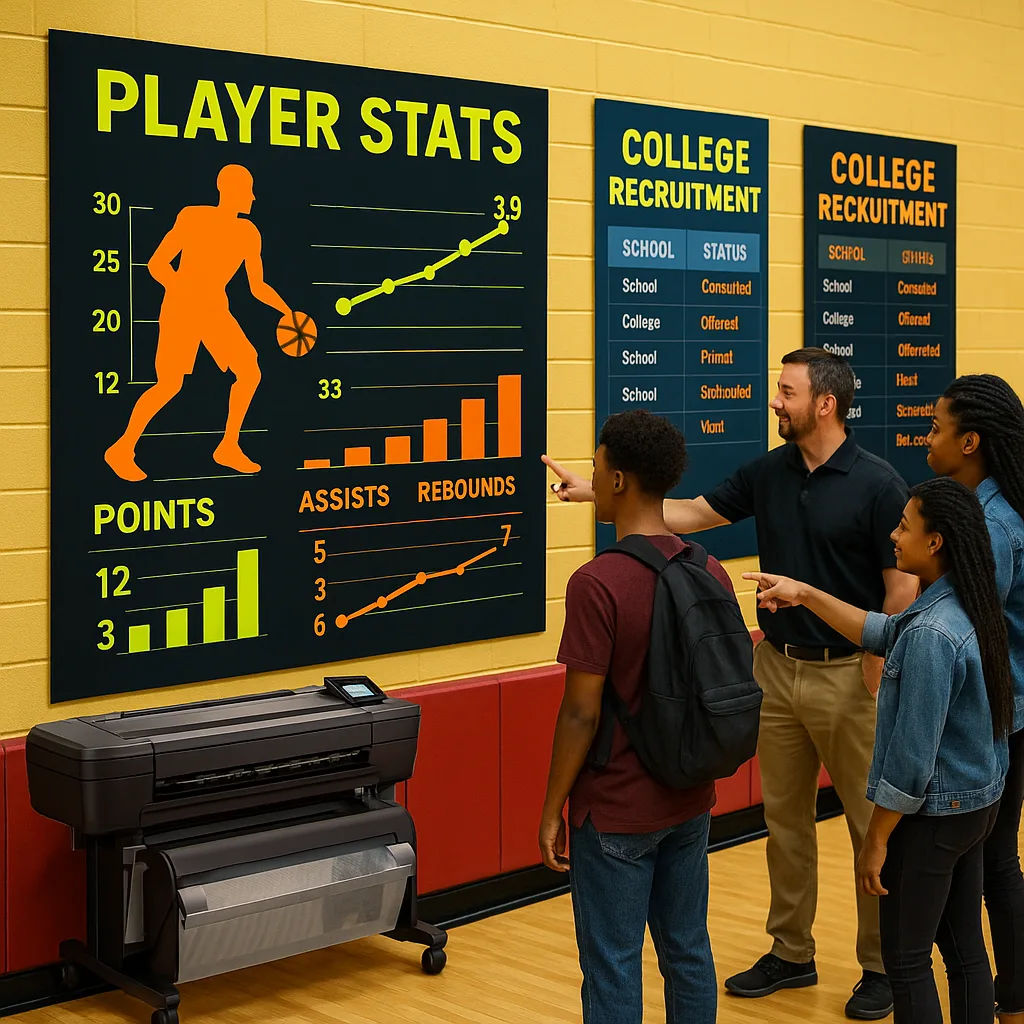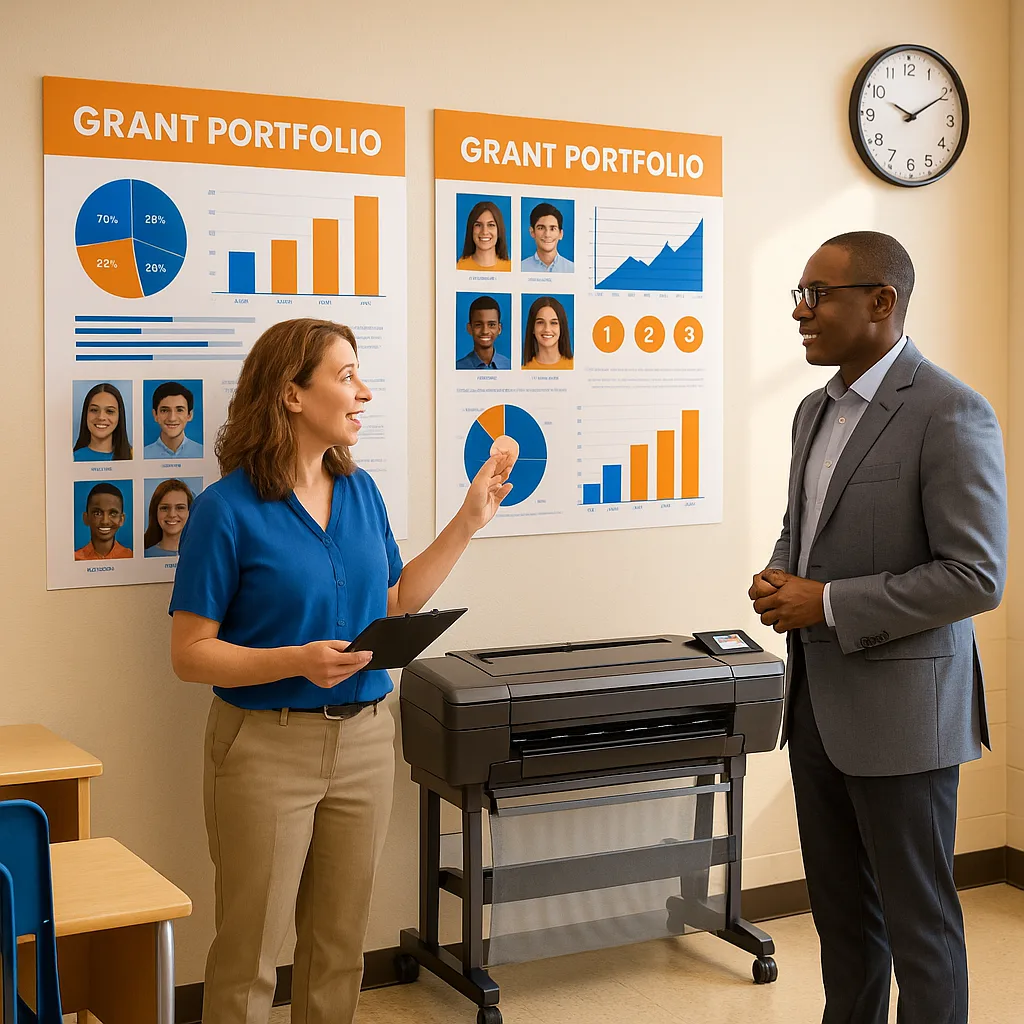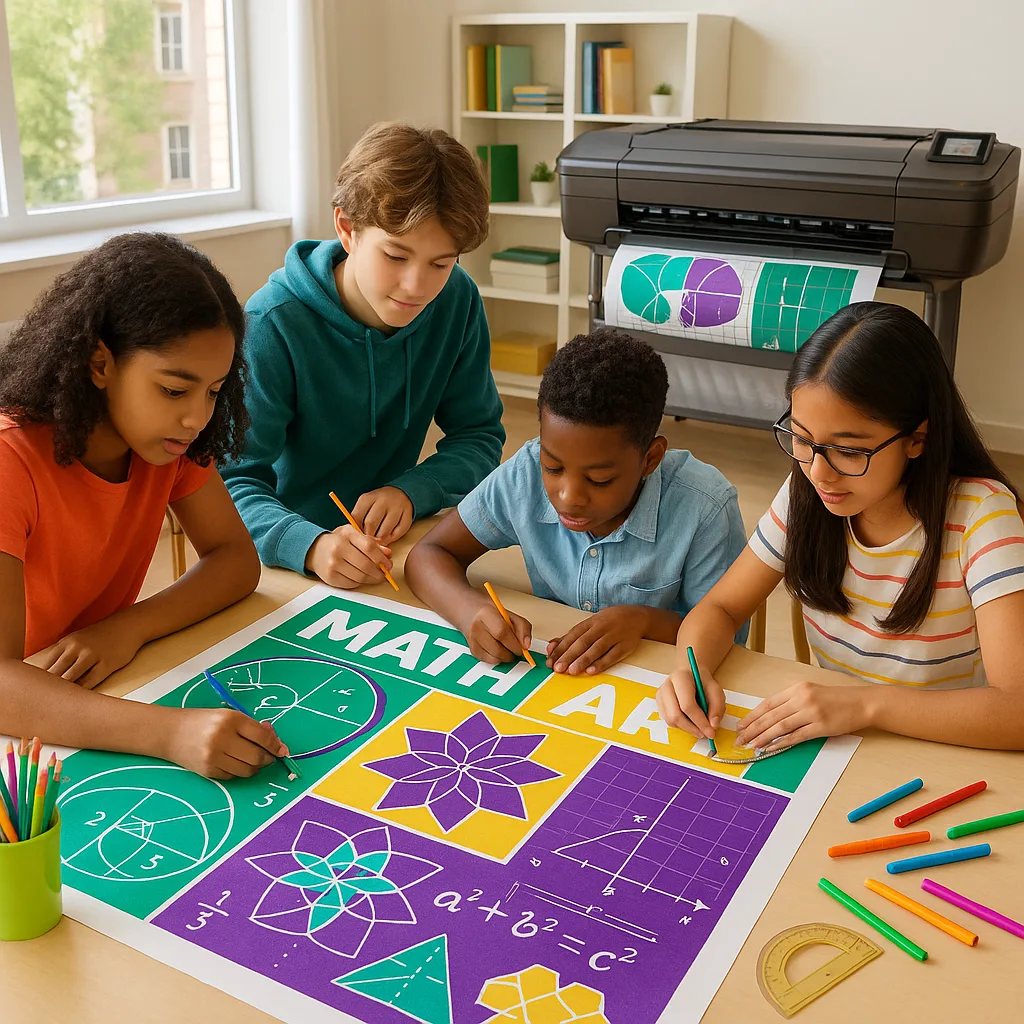
Picture this: Your students huddle around a massive poster, rulers in hand, measuring angles for a tessellation that would make M.C. Escher proud. Meanwhile, another group uses vibrant paints to create fraction pizzas that practically leap off the page. This isn’t just art class or math class—it’s both, beautifully intertwined through the magic of poster maker machines for STEAM education.
Why Mathematical Art Projects Matter More Than Ever
For years, I’ve watched students’ eyes glaze over when faced with abstract mathematical concepts. However, something magical happens when we transform those same concepts into large-scale visual art projects. Furthermore, research from Stanford’s Jo Boaler shows that students who experience mathematics visually and creatively develop stronger neural pathways for mathematical thinking.
Recently, our hallway gallery featured a stunning 36-inch geometric mandala created by seventh graders. Subsequently, parents stopped mid-stride, phones out, capturing not just art but living proof of the Pythagorean theorem. Most importantly, the students who created it? They’ll never forget how a² + b² = c² because they painted it, measured it, and made it beautiful.
10 Cross-Curricular Poster Activities for STEAM Success
Each activity below includes mathematical objectives, artistic elements, and assessment strategies. Additionally, I’ve noted differentiation tips to ensure every learner finds their creative confidence.
1. Fraction Pizza Parlor
Math Focus: Fractions, equivalence, addition
Art Elements: Color mixing, realistic food illustration
Students design oversized pizza posters showing different fraction combinations. For instance, one quarter pepperoni plus one half cheese equals three quarters covered. Moreover, they must create appetizing toppings using proper shading techniques.
Assessment: Accuracy of fraction representation (40%), artistic execution (30%), written explanation (30%)
2. Tessellation City
Math Focus: Geometry, transformations, patterns
Art Elements: Pattern design, spatial planning
Groups create cityscapes using only tessellating shapes. Subsequently, they calculate area coverage and identify transformation types. Furthermore, advanced students incorporate multiple tessellation patterns within one poster.
Differentiation: Provide templates for struggling students; challenge advanced learners with irregular tessellations
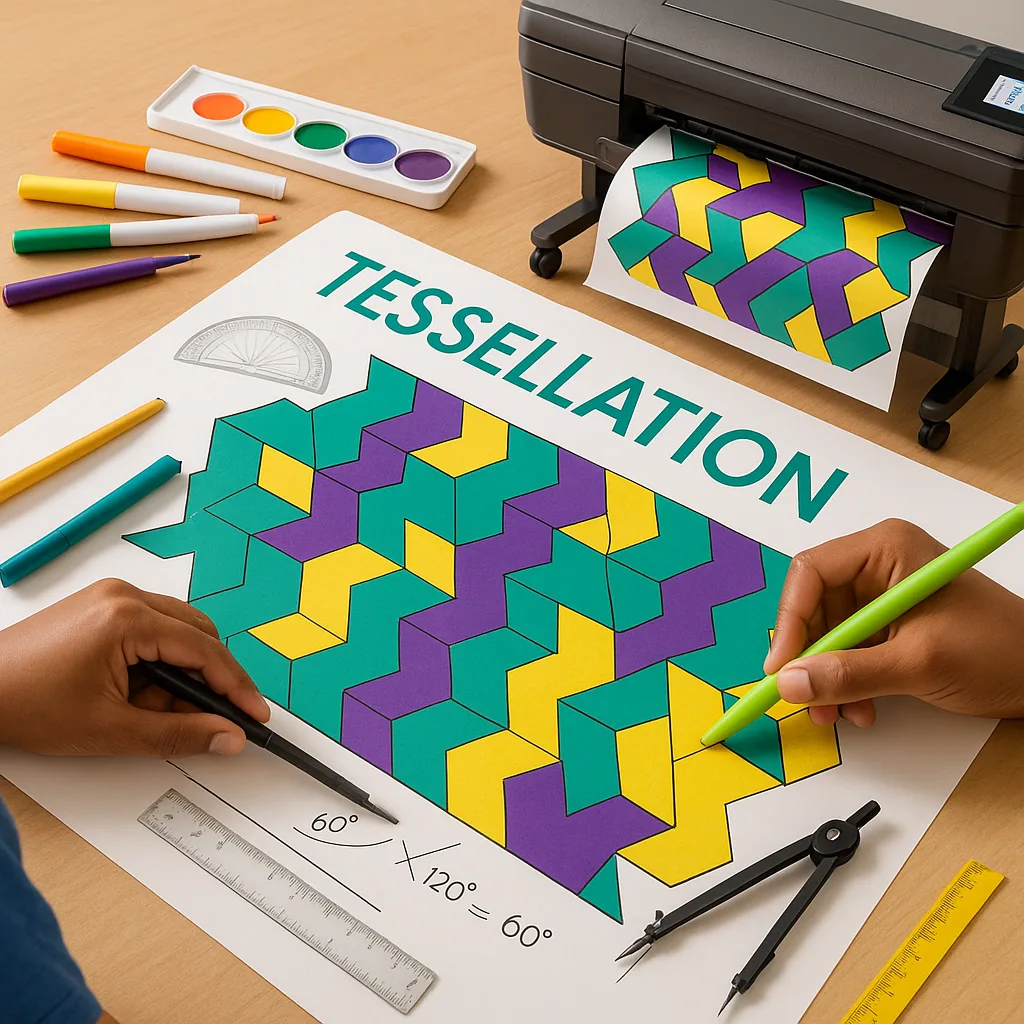
Student engagement increase with visual math projects
Better retention of mathematical concepts
Of teachers report increased creativity
3. Fibonacci Nature Spirals
Math Focus: Number sequences, ratios, natural mathematics
Art Elements: Observational drawing, organic forms
Students photograph natural objects displaying Fibonacci sequences, then create large-scale interpretive posters. Consequently, they annotate mathematical relationships directly on their artwork. Additionally, this project connects beautifully with science curriculum standards.
Materials needed: When schools invest in poster maker machines for schools, the only ongoing cost is paper and ink—making these projects surprisingly affordable.
4. Coordinate Grid Murals
Math Focus: Coordinate planes, plotting points, scale
Art Elements: Grid method drawing, proportional scaling
Each student receives a small section of a larger image with coordinate points. Therefore, when assembled on poster-sized grids, individual pieces form stunning collaborative murals. Moreover, this activity naturally promotes teamwork and precision.
Understanding Poster Maker Machines for STEAM Projects
When considering the poster maker machine for schools cost, remember you’re investing in unlimited creative possibilities. Initially, the price might seem substantial. However, when you calculate per-poster expenses (typically $1.30-$1.50), it becomes remarkably economical compared to outsourcing.
Furthermore, modern poster printing solutions offer features specifically designed for educational settings:
• Instant dry technology prevents smudging during enthusiastic student handling
• Water-resistant options for long-lasting hallway displays
• Software that integrates with popular educational platforms
• 5-year warranties ensuring worry-free operation
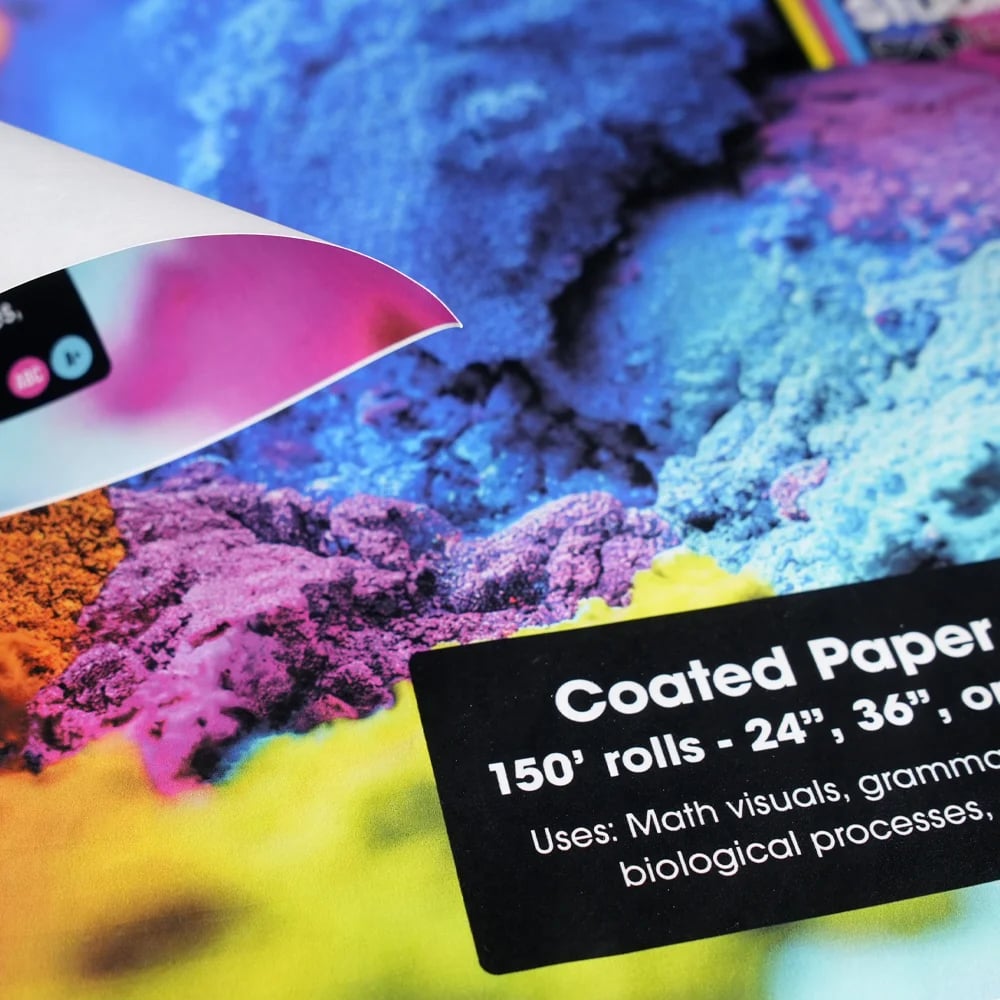
Professional results every time with quality materials
5. Symmetry Self-Portraits
Math Focus: Line symmetry, reflection, measurement
Art Elements: Portrait drawing, mirror imaging
Students photograph half their face, then mathematically construct the mirror image. Subsequently, they explore how slight asymmetries create uniqueness. Additionally, this project builds self-esteem while teaching precision.
Extension: Create radial symmetry portraits for advanced mathematical challenge.
6. Data Visualization Gardens
Math Focus: Data collection, graphing, statistics
Art Elements: Infographic design, color coding
Transform boring bar graphs into blooming flower gardens where petal sizes represent data points. Therefore, students learn data visualization while creating gallery-worthy art. Moreover, this approach makes statistics accessible to visual learners.
Real classroom example: Third graders tracked reading minutes, creating sunflowers where each petal represented 10 pages read. Consequently, our hallway became a literacy garden celebrating growth!
7. Angle Architecture
Math Focus: Angle measurement, geometric shapes, structural engineering
Art Elements: Architectural drawing, perspective
Students design fantastical buildings using specific angle requirements. For instance, “Include three 45° angles, two right angles, and one obtuse angle.” Additionally, they calculate total degrees in their polygonal floor plans.
Cross-curricular connection: Partner with history classes to recreate historical architecture mathematically.
8. Pattern Rhythm Posters
Math Focus: Pattern recognition, sequences, multiplication
Art Elements: Rhythm in visual design, repetition
Connect music and math by translating rhythmic patterns into visual sequences. Therefore, students see how mathematical patterns create both visual and auditory beauty. Moreover, this activity supports multiple learning styles simultaneously.
Materials: Quality poster paper ensures vibrant colors that make patterns pop—check specialty papers for best results.
Assessment Strategies That Celebrate Growth
Traditional math tests often miss the creative problem-solving these projects develop. Therefore, I’ve developed rubrics that honor both mathematical accuracy and artistic expression.
Mathematical Accuracy (40%)
Calculations, measurements, and mathematical relationshipsDetailed Criteria
• Correct application of formulas• Accurate measurements and calculations
• Proper use of mathematical vocabulary
• Evidence of mathematical thinking process
Artistic Expression (30%)
Visual impact, creativity, and technical art skillsCreative Elements
• Creative interpretation of mathematical concepts• Effective use of color and composition
• Technical art skill development
• Overall visual appeal and craftsmanship
9. Volume Sculptures Posters
Math Focus: Volume calculation, 3D geometry, spatial reasoning
Art Elements: Paper engineering, 3D design
Students create poster backgrounds featuring cityscapes, then add pop-up 3D buildings with calculated volumes. Subsequently, they must show their work artistically integrated into the design. Furthermore, this project makes abstract volume concepts tangible.
Technology tip: Use design services to create professional templates students can customize with their calculations.
10. Mathematical Mandala Meditation
Math Focus: Radial symmetry, angle division, geometric construction
Art Elements: Meditative drawing, cultural art forms
Create large-scale mandalas using mathematical precision. Initially, students divide circles into equal sections using protractors. Then, they develop patterns following mathematical rules. Additionally, this calming activity reduces math anxiety while building skills.
Cultural connection: Research mathematical patterns in various cultural art forms, celebrating diversity through mathematics.
Ready to Transform Your Math Classroom?
Discover how affordable it is to bring these creative math projects to life with professional-quality poster printing.
Implementation Tips for Success
After years of facilitating these cross-curricular projects, I’ve learned what makes them soar or stumble. First, always start with a mini-lesson on both the math concept and art technique. Second, provide visual examples—but emphasize there’s no single “right” outcome. Third, build in reflection time where students explain their mathematical thinking through artist statements.
Most importantly, display every creation with equal prominence. Recently, a struggling math student’s tessellation poster sparked a conversation with her engineer parent about Islamic geometric patterns. Suddenly, math wasn’t just homework—it was heritage, beauty, and possibility rolled into one vibrant display.
When schools invest in proper poster-making equipment, these projects become sustainable parts of curriculum rather than special occasions. Furthermore, the poster maker machine for schools cost becomes negligible when divided by years of creative learning opportunities.
The Gallery Effect: Building Community Through Mathematical Art
Every semester, we transform our main hallway into a mathematical art gallery. Parents arrive for conferences and stop, mesmerized by the Fibonacci spirals, tessellation cities, and data gardens. Subsequently, conversations shift from “My child struggles with math” to “I had no idea math could be so beautiful!”
This visibility matters. When younger students see older students’ mathematical artwork displayed prominently, they anticipate their turn. Moreover, when we use professional printing equipment, student work gains the respect it deserves. Therefore, math transforms from abstract concepts to celebrated achievements.
Remember, these projects succeed because they honor both hemispheres of the brain. Additionally, they create safe spaces for mathematical risk-taking—when art is involved, there’s always something to celebrate. Most importantly, they prove that mathematics isn’t just about right answers; it’s about seeing patterns, making connections, and creating beauty from logic.
Your students are ready to discover the artist within the mathematician and the mathematician within the artist. Furthermore, with the right tools and these proven activities, you’re ready to guide them there. So grab those rulers, mix those paints, and let’s make math magnificent!





